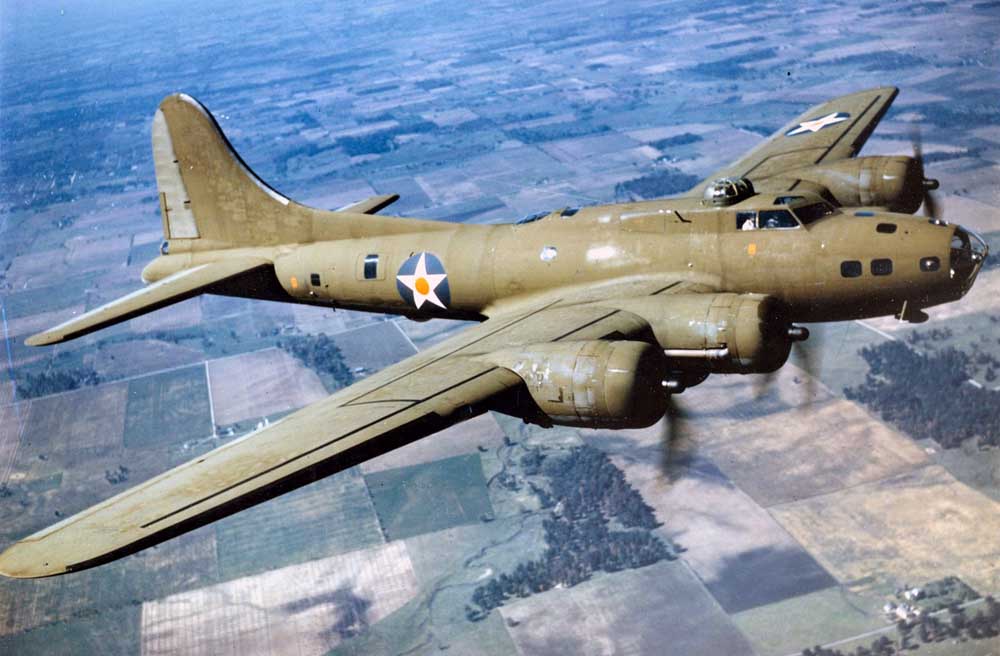WWII memories, kept alive in ink
Published 12:00 am Sunday, May 4, 2014

- U.S. Air Force Museum / Submitted photoDuring the final days of World War II, Tumalo native Fredric Shepard flew a B-17 Bomber such as this one on 33 missions over Germany and occupied Europe.
Seventy years ago, Tumalo native Frederic Shepard traveled to the Drew Army Airfield outside Tampa, Fla., so he could learn how to fly a Boeing B-17 Flying Fortress with the 306th Bombardment Group (Heavy) during World War II.
Based out of an American-controlled airfield in Thurleigh, England, this unit was the first bomber group in the Eighth Air Force to complete 300 missions over occupied Europe and Germany — it also gained fame for being the first bomber group to strike Nazi Germany directly — and later inspired the Gregory Peck movie, “Twelve O’Clock High.”
Shepard took part in 33 bombing missions during his service with this unit from October 1944 through May 1945. But his daughter Carolyn Courtwright, of Bend, said he never talked about this experience with his children during the latter part of his life, when he sold insurance and served as a county commissioner in Spokane County, Wash. The only war story he shared with his family involved a potato his father sent him from Oregon that he dropped on Germany during one of his missions, Courtwright said.
Shepard died in 1990 at age 67. Courtwright said that after her father’s death, she and her siblings turned up a copy of a journal he kept during the war that detailed his day-to-day experiences and the bombing raids he conducted. Included in his journal are his experiences of Victory in Europe Day, the day on which the Allied Forces accepted the unconditional surrender of the German armed forces. Thursday is the 69th anniversary of V-E Day.
Below are excerpts from Shepard’s journal.
• Oct. 7, 1944 (First combat mission): Combat mission to Ruhland, Germany, where we hit a large synthetic oil plant visibly. Crossed Czechoslovakia border during flight. … Only had a few flak holes. Bombed at 27,000 feet.
• Nov. 21, 1944 (Eighth combat mission): Tried to fly mission to Merseburg but the weather kept us from the target. Wound up trying to drop on airfield (in Holland) but we had a rack malfunction so our bombs wouldn’t drop. While over Mingen, in an attempted run on Oznabrück a piece of flak came in cockpit and knocked the clock in the V of the windshield out.
A tail gunner (who was found in the water after a Nov. 14 plane crash) was in a ship knocked down over Mingen. It was his first mission since that date.
• Dec. 22, 1944 (At base between 13th and 14th combat missions): We are complaining plenty these days because we can’t get off to help our boys on the front who are doing their best against a great German counter offensive.
A heavy fog has lain over base for the last four days. The Germans have advanced at least 40 miles into Belgium and must be given credit for timing their offensive with such favorable weather for their side.
• Jan. 8, 1945 (17th combat mission): Hit rail yards in Mannheim area through a break in the clouds. Flak was moderate and accurate. J.L. Davis returned to base with his one and two engines feathered and didn’t quite make the runway but stalled out, ground looped on the end, warping his left wing by twisting it, collapsing tail wheel and ball turret.
No one was hurt. We got only about three or four holes about the size of my fist.
• Feb. 3, 1945 (At base between 23rd and 24th combat missions): I did not fly today but the target for 1,000 fortresses was the heart of Berlin which was attacked visually and with excellent results.
My squadron lost three ships. … Becker, who was my bombardier until he was made a navigator and sleeps next to me, was flying with Daley on his 35th mission. Petrillo, my ball turret gunner, was in the same plane on his 95th combat mission, his 30th and last in this theater. They ditched between Hamburg and England in the North Sea. No word has been received from them.
• Feb. 24, 1945 (26th combat mission): Flew mission to Hamburg to hit an oil refinery. … We bombed from 22,800 feet. The flak was heavy but inaccurate. I dropped a rotten potato dad sent me from Oregon, right on Hamburg. I’ll bet that made the Germans scatter for it was very soupy. That is unless they ate it.
• March 21, 1945 (Touring London on leave between 26th and 27th combat missions): We drove only a block more to where William Penn was born. The house is no more … as a result of the bombing. Across the street is the church where he was baptized, but only the walls are standing thanks to the German Air Force.
We then went to the part of London hit most severely by the Blitz. Here where four and five story buildings once stood you find blocks of basements and stone foundations. Occasionally you see a hollow shell of a building still standing, but it is no good. … Fire is really what wiped this great section of warehouses, etc., out. Fifty miles from London that Saturday night, when the Germans came over all night long, it was like day from the blaze which burned for weeks. The water lines were all broken so they couldn’t fight the fire much and just had to let it burn. … It took two years to find the streets.
• April 6, 1945 (30th combat mission): Today we hit the marshaling yards at Plattling, about 125 miles southeast of Nuremberg and 50 miles southeast of Regensburg. … On the way over we saw an oil tanker in the channel burning fiercely. The whole ship was engulfed in flames and the black smoke rose thousands of feet. It must have hit a mine. I also saw a town on fire in Germany. Whole blocks were ablaze. This was the first time I have ever seen bombing results so clearly.
• May 7, 1945 (After 33rd combat mission): According to teletype reports in the intelligence room, the Germans have signed the unconditional surrender terms of the Allies. Some of my barrack buddies and I went to town and had quite a celebration. The English in Bedford had all their blackout curtains down and all houses and business houses had a flag out.
• May 8, 1945 (Victory in Europe Day): Peace has come to Europe. Today is the official V.E. Day although the surrender took place yesterday morning. … The Red Cross is putting on a big shindig here tonight as we have been restricted to the post for 24 hours. I understand they have 1,800 gallons of beer. I’m not going to it though as I’m tired from last night and am scheduled to fly in the morning.
• May 9, 1945 (After V-E Day): Today I flew an observation flight over Germany carrying 10 men from the Air Traffic Control base at Bobbington as passengers. We flew a very loose formation, if you could even call it that, so we could see everything quite well.
Our route went in over Brussels where we did a couple of 360 degree turns in order to have a better look at this capital city. … As yesterday was VE Day, flags were flying from most all the buildings in Belgium and in what little part of France we crossed. One Brussels street had big letters … saying “WE THANK YOU.” The country here is not messed up much.
The story is not nearly the same when you cross the German border. … Coming up on Aachen, one sees what appears to be a regular town. However, when over it, one sees debris all over the place and no roofs are on the buildings. They are all shells if still standing. I saw Eschweiler, where I dropped bombs Nov. 16, 1944, in close support of the ground forces. The 8th Air Force dropped 100 pounders over this area and the bomb craters are very well distributed.
The next town was Duren, probably the flattest town in Germany. Its center looks like piles of sand as hardly a wall stands. … You see very few people in these towns but those you do see don’t look up, where as the Belgians waved eagerly. The Germans are certainly a defeated people and apparently don’t think much of our flying over their ruined country gloating over our victory.
• May 12, 1945 (Heading home): On return from today’s “Tour of the Ruhr,” my third, I was given a list of the crew to get together and prepare to leave Monday for the Zone of the Interior (United States).
• May 22, 1945 (Homecoming): Took off for Bradley Field, Conn. We were the first to return in all the 8th and 15th Air Forces so reporters and photographers had the place swamped. I was the 20th plane to land and the first B-17.
— Reporter: 541-617-7816, mmclean@bendbulletin.com






